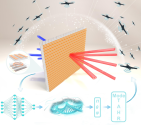Integrated electromagnetic sensing system based on a deep-neural-network-intervened genetic algorithm.
Abstract
With the deepening integration of artificial intelligence (AI) and the Internet of Things (IoT) in daily life, electromagnetic sensing presents both attraction and increasing challenges, especially in the diversification, accuracy, and integration of sensing technologies. The remarkable ability of metasurfaces to manipulate electromagnetic waves offers promising solutions to these challenges. Herein, an integrated system for electromagnetic sensing and beam shaping is proposed. Improved genetic algorithms (GAs) are employed to design the metasurface with desired beams, while spatial electromagnetic signals sensitized by the metasurface are input into the GA enhanced by deep neural networks to sense the number of targets, their azimuths, and elevations. Subsequently, the metasurface device is designed as the hybrid mode combining tracking and avoidance in alignment with practical requirements and sensing outcomes. Simulation and experimental results validate the efficiency and accuracy of each module within the integrated system. Notably, the target sensing module demonstrates the capability to precisely sense more than 10 targets simultaneously, achieving an accuracy exceeding 98% and a minimum angular resolution of 0.5°. Our work opens, to our knowledge, a new avenue for electromagnetic sensing, and has tremendous application potential in smart cities, smart homes, autonomous driving, and secure.

